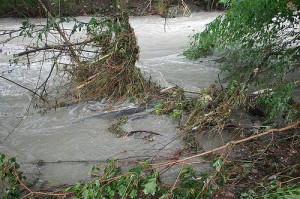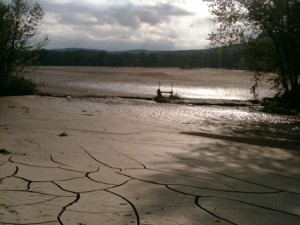The Rivers Are Not Broken—Stop Trying to Fix Them
From Whitty Sanford

The unrelenting precipitation from Irene and other storms this fall caused rivers to rise and flows to increase. Rivers turned brown, jumped their banks and poured into their floodplains where they unfortunately flooded homes, businesses, farm fields and forests. They eroded our roads and swept away bridges and buildings. The wide spread devastation was stunning and saddening and many people are asking: “What went wrong with our rivers?”
The answer is nothing. A river is an exquisitely balanced natural system that is controlled by the laws of nature. It behaves as it does because of the well understood principles of gravity, force, work and friction, which control its hydrological functions. A river has no choice in the matter. The laws of nature are in charge and despite those who would do so; these laws cannot be ignored, modified or repealed.
In real life, interference with the natural dynamics of a river changes how a river behaves during high flow events. Human modifications to a river – building in its floodplain, straightening its course (channelizing), removing gravel from a streambed (dredging), removing natural plants from the riparian zones, replacing vegetation (trees and shrubs) along a river’s banks with hard armor rip rap, and shutting a river off from its floodplain with berms, roadways and train tracks – are actions that increase the exposure of property to damage during flooding.
An unmodified river during high water mainly transports two things, water and sediment. Until the terrain of Western Massachusetts is eroded down to sea level, our streams, which feed the Connecticut, Housatonic, and Hudson Rivers, will continue to move sediment to the sea. Gravity induces water to flow downhill. The friction between water and land plucks pieces of our mountains and valleys (soil, sand, pebbles and detritus) eventually depositing a suspended mix of sediment in the sea.
The damage we see during flooding now is in large measure due to our own activities that encroach physically on our rivers. In the 19th Century, we choked our river valleys with sediment washed down from our mountains after we stripped them of trees. Our streams still are recovering from that onslaught.

Today, we cause rivers to rise faster when we create surfaces (parking lots, driveways, roads and roof tops) that do not absorb water but shoot it right into our rivers. We increase the erosive power of rivers when we reduce or block their access to floodplains, fill wetlands, and strip the trees and bushes from riparian zones. We destabilize our rivers when we create pinch points at under sized bridges and culverts, remove measurable amounts of gravel, and straighten or move streambeds. These actions guarantee an increase in damage to property during flooding.
We will not stop rivers from flooding by making rip rap stone larger, berms higher or streambeds arrow straight. Instead to lessen the impacts from events like Irene, humans should rethink the way we develop land and where we build. Our rivers need to be able to access their floodplains and wetlands where their flows can spread out and slow down and to form meanders so their bends and oxbows absorb the force of river flows. To achieve stability, we should make it possible for our rivers to move naturally and to deposit gravel as they have done for millennia.
During flood events rivers set the stage for reducing impacts in subsequent storms. They expand their floodplains, increase meanders and create wider channels to absorb flows. When humans intervene with non-natural “fixes,” we take away natural adjustments rivers make for themselves. Dredging, straightening and/or berming rivers creates unstable streams heightening the odds that the next high water will increase the destruction to the property, crops and infrastructure, we are trying to protect.
Human intervention also wreaks havoc on habitat for aquatic life, which in turn can destroy a stream’s fishery and recreational attributes. Western Massachusetts is renowned for its racing, mountain streams. It would be sad to lose that reputation.
If the last 20 years are any indication, flooding is increasing and will always be a threat, so it is a good time to begin to work with Mother Nature by adapting to a river’s requirement to spread out when it floods. Instead of “fixing” our streams, we should rethink our methods for developing/building near them and if we do build near them we should construct buildings that can cope with high water and deal with flooding. Basically, it is up to us to anticipate what a river will do in a flood and to modify our activities not our rivers in order to prepare for flooding.

In the future, residents of Western Massachusetts can turn this fall’s disaster into an opportunity by rethinking the restoration of their communities and planning for the economic revitalization of the region. The Deerfield, South, North, and Green Rivers have offered us a challenge. We can meet it by making the right choices for our rivers, communities and environment through good planning, land conservation, and river protection.
Whitty has lived in Western Massachusetts for 20 years and co-directed the Connecticut River Watershed Council. This article was adapted and edited by Whitty from a piece written for CRWC by River Steward David Deen.